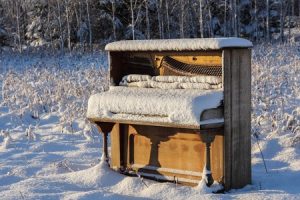Just as you take the fall months to prepare your home for the cold season ahead, you should also take care to prepare your piano to play properly during the snowy season. With winter right around the corner, now’s the time to make sure that you’re ready to stay in tune for fall lessons, holiday rehearsals and seasonal songs and carols. Here are a few tips to make sure that you stay on pitch all winter long.
Humidifier
One reason that pianos fall out of tune during the colder months is the drop in humidity. As you close up your home and begin to turn the heat on, the moisture content in your home’s air begins to drop, which can pull some of the moisture out of your piano. This can ultimately lead to problems with your piano as the wood and felt begins to dry out, causing the wood to shrink and reducing the tension on the strings, leading to flat notes. These fluctuations can also pull on the glue that keeps felt in place or even allow aged, brittle components to develop faults or cracks. Using a humidifier unit in the space where your piano is can help keep your piano in better playing condition and prevent dryness from drying out your perfect pitches.
Location
 Pianos, by their nature, are meant to be kept in a somewhat stationary place, preventing them from being jostled about and loosening components. However, a slight move of a few feet will not often harm a piano, and may be to its benefit. One such instance is planning for winter and moving a piano away from overly cold or warm spots. If you have the space and location to move your piano, placing it away from frequently opened doors or windows and removed from the direct blast of warm air registers or radiators can help keep your piano playing well. While temperature is not a primary concern that affects pianos dramatically, these factors can impact the wood indirectly – often as it relates to humidity. If you can, keep your piano in a consistently even-heated room and away from these frequent changes or alterations in temperatures that can impact your instrument’s musical quality.
Pianos, by their nature, are meant to be kept in a somewhat stationary place, preventing them from being jostled about and loosening components. However, a slight move of a few feet will not often harm a piano, and may be to its benefit. One such instance is planning for winter and moving a piano away from overly cold or warm spots. If you have the space and location to move your piano, placing it away from frequently opened doors or windows and removed from the direct blast of warm air registers or radiators can help keep your piano playing well. While temperature is not a primary concern that affects pianos dramatically, these factors can impact the wood indirectly – often as it relates to humidity. If you can, keep your piano in a consistently even-heated room and away from these frequent changes or alterations in temperatures that can impact your instrument’s musical quality.
Tuning
The last thing you can do to help stop the frosty season from putting a chill on your sound quality is having your piano tuned. Most regularly used pianos should be tuned at least twice a year, and timing your tuning around the change of seasons can allow your tuner to adjust your piano as may be necessary for the season. When tuning pianos in the fall, your tuner can put the piano in tune or even tune slightly sharp to account for the flatness that often comes with dryer air during the colder months. This can help your piano maintain a more consistent sound and tuning stability through the winter season, or until your next tuning session.
Now’s the perfect time to have your piano tuned to make sure that you’re ready for winter. At East Coast Piano Rebuilding, we offer comprehensive tuning appointments and repair work – as needed – to make sure that you’re always sounding your best. Contact us today to schedule your appointment!

Leave a Reply